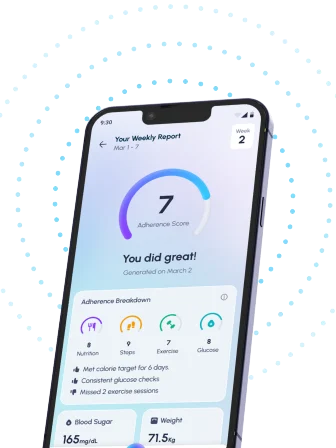Table of Contents
- New Hope for Diabetes: Targeting Senescent Cells
- Senescent Cell Reduction: A Promising Diabetes Treatment?
- Understanding Senescent Cells and Their Role in Diabetes
- Can Removing Senescent Cells Reverse Diabetes? New Research
- A Guide to Senescent Cell Therapies for Diabetes Management
- Frequently Asked Questions
- References
Living with diabetes can feel like an uphill battle, but what if I told you there’s new hope on the horizon? Recent research is generating excitement around a potential game-changer: senescent cell reduction. This innovative approach targets aging cells that contribute to the complications of diabetes, offering a promising new avenue for treatment and improved management. We’ll explore the science behind this exciting development and what it could mean for the future of diabetes care in this blog post, so let’s dive into New Hope for Diabetes: Senescent Cell Reduction Shows Promise.
New Hope for Diabetes: Targeting Senescent Cells
The global burden of diabetes is staggering, with a shocking statistic highlighting that 50% of diabetes cases worldwide are undiagnosed. This alarming figure, as detailed in the International Diabetes Federation’s Diabetes Atlas, is particularly relevant in India and other tropical countries where diabetes prevalence is rising rapidly. The good news is that promising research offers new avenues for treatment and prevention, focusing on senescent cells.
Understanding Senescent Cells and their Role in Diabetes
Senescent cells, essentially aging cells that have stopped dividing, contribute significantly to age-related diseases, including type 2 diabetes. These cells release inflammatory molecules that damage surrounding tissues and impair insulin function, a key factor in diabetes development. Targeting these senescent cells through novel therapies offers a potential breakthrough in managing and even preventing the disease, especially in high-risk populations in India and other tropical regions.
Potential for Treatment and Prevention in Tropical Regions
Research into senescent cell reduction, or senolytics, is ongoing, with several promising studies showing positive impacts on various age-related conditions. This holds particular significance for countries in tropical climates, where lifestyle factors and genetic predispositions can contribute to higher diabetes rates. Early detection and intervention, along with lifestyle changes, are crucial. The development of effective senolytic therapies could offer a powerful additional tool in combating this global health challenge. Furthermore, exploring how new technological advances can improve diabetes lifestyle is crucial for better management.
Taking Action: Steps Towards Better Diabetes Management
While research continues, individuals in India and other tropical countries can proactively manage their diabetes risk. Regular check-ups, maintaining a healthy weight, adopting a balanced diet rich in fruits and vegetables, and incorporating regular exercise are vital steps. Stay informed about advancements in diabetes research and consult with your healthcare provider to discuss the potential benefits of emerging treatments. Early intervention and a proactive approach are essential to combating the growing diabetes epidemic. Remember that boosting immunity while managing diabetes is also key to overall well-being.
Senescent Cell Reduction: A Promising Diabetes Treatment?
The fight against diabetes, particularly Type 2, is gaining momentum with exciting new research. While lifestyle changes, such as diet and exercise, play a crucial role—up to 80% of Type 2 diabetes cases can be delayed or prevented through lifestyle changes—scientists are exploring innovative therapeutic avenues. One such promising area focuses on senescent cell reduction. These “zombie cells,” which accumulate with age, contribute to inflammation and cellular dysfunction, factors significantly implicated in the development of diabetes.
Targeting Senescent Cells in Tropical Climates
The implications of senescent cell reduction for diabetes management are particularly relevant in India and other tropical countries. These regions often face challenges related to dietary habits, physical activity levels, and access to healthcare, increasing the prevalence of diabetes. Therefore, exploring novel therapeutic approaches, like targeting senescent cells, offers a potential game-changer in the fight against this chronic disease. Further research is needed, but the initial findings are encouraging, suggesting a potential complementary strategy alongside established preventative measures.
Actionable Steps for Prevention and Management
While research into senescent cell reduction continues, individuals can take proactive steps to manage their diabetes risk. Adopting a healthy diet rich in fruits, vegetables, and whole grains, engaging in regular physical activity, and maintaining a healthy weight are crucial. These lifestyle modifications, combined with regular medical check-ups, can significantly reduce the risk of developing Type 2 diabetes, particularly in high-risk populations within Indian and tropical regions. Consult your doctor to discuss personalized strategies for diabetes prevention and management tailored to your specific needs and circumstances. For those already diagnosed, understanding the complexities of the disease is crucial. Learning about potential complications, such as Does Diabetes Cause Low White Blood Cell Count? can empower individuals to take proactive steps towards better management. And for those seeking information on reversing diabetes, exploring resources on How to Reverse Diabetes Permanently might be beneficial.
Understanding Senescent Cells and Their Role in Diabetes
The Silent Threat of Senescent Cells
Diabetes, a growing concern globally, particularly impacting a significant portion of the population in India and other tropical countries, is increasingly linked to the accumulation of senescent cells. These “zombie cells,” while not actively dividing, release inflammatory molecules that contribute to various age-related diseases, including diabetes complications. Understanding their role is crucial for developing effective treatments. The fact that 61% of people with diabetes are aged between 20-64 years, and a further 39% are 65+, as highlighted by the International Diabetes Federation (IDF Diabetes Atlas), underscores the urgency of this research.
Senescent Cells and Diabetes Complications
Senescent cells contribute to the chronic inflammation associated with type 2 diabetes, accelerating the progression of complications like cardiovascular disease, kidney disease, and nerve damage. These complications are particularly prevalent in regions with high diabetes prevalence, such as many parts of India and other tropical nations. The chronic inflammatory environment created by these cells can also impair insulin sensitivity, worsening glucose control. This highlights the need for research focusing on interventions that specifically target senescent cells in diverse populations.
Hope on the Horizon: Senescent Cell Reduction
Recent research focuses on senescent cell reduction, or senolytics, as a potential therapeutic strategy. While still in its early stages, this approach offers a promising avenue for mitigating the harmful effects of these cells on diabetes progression and associated complications. The development of effective senolytic therapies could significantly improve the lives of millions living with diabetes, particularly in high-risk regions. Further research tailored to the specific needs and demographics of Indian and tropical populations is essential. This includes considering factors like genetic predisposition, lifestyle, and environmental influences.
Taking Action: Prioritizing Prevention and Early Detection
While groundbreaking research on senolytic therapies is underway, prevention and early detection remain critical. Maintaining a healthy lifestyle, including balanced nutrition, regular exercise, and stress management, is crucial in slowing the accumulation of senescent cells and reducing the risk of developing diabetes. Regular health check-ups, particularly in high-risk populations, are also essential for early diagnosis and intervention. This proactive approach is paramount for improving diabetes outcomes across all regions, especially in high-prevalence areas like India and tropical countries. For more information on the impact of lifestyle choices, read our article on Understanding the Link Between Diabetes and Obesity. Getting enough quality sleep is also vital; check out The Importance of Quality Sleep in Managing Diabetes for more details.
Can Removing Senescent Cells Reverse Diabetes? New Research
The global burden of diabetes is staggering, costing the world economy $760 billion annually. This significant economic impact underscores the urgent need for innovative treatment approaches. Recent research offers a glimmer of hope, focusing on the role of senescent cells in the development and progression of diabetes. These “zombie cells,” which accumulate with age and contribute to inflammation, are now being investigated as potential therapeutic targets.
Targeting Senescent Cells for Diabetes Management in Tropical Climates
Studies suggest that senescent cells contribute to insulin resistance and pancreatic beta-cell dysfunction, key features of type 2 diabetes. The exciting possibility of selectively removing these cells is gaining traction as a potential therapy. This is particularly relevant in Indian and tropical countries, where diabetes prevalence is high and often exacerbated by lifestyle factors and environmental conditions. Further research is needed to understand fully how senescent cell reduction impacts diabetes management within diverse populations and specific climatic contexts. However, this avenue holds significant promise. For more on alternative approaches, explore how a change in diet might help: Can a Plant-Based Diet Reverse Diabetes?
Practical Steps and Future Outlook
While removing senescent cells directly isn’t yet a readily available treatment, maintaining a healthy lifestyle is crucial. This includes a balanced diet rich in fruits, vegetables, and whole grains, regular exercise, and effective stress management – all vital for preventing senescent cell accumulation and mitigating the risk of diabetes in Indian and tropical populations. Staying informed about ongoing research and consulting with healthcare professionals is key to accessing the latest advancements in diabetes management. The future of diabetes treatment may lie in targeting senescent cells, offering new hope for millions. And for those interested in the role of technology, How AI Can Help You Reverse Diabetes offers an insightful look at emerging possibilities.
A Guide to Senescent Cell Therapies for Diabetes Management
Understanding Senescent Cells and Their Impact on Diabetes
Diabetes significantly increases the risk of complications, with nearly 15% of diabetics experiencing debilitating foot ulcers in their lifetime. These ulcers often lead to amputations, a devastating outcome impacting quality of life. Recent research suggests that senescent cells—cells that have stopped dividing but don’t die—play a crucial role in the development and progression of diabetic complications. These “zombie cells” release harmful substances that contribute to inflammation and tissue damage, exacerbating conditions like foot ulcers. Senolytics, therapies designed to selectively eliminate senescent cells, offer a potential new avenue for diabetes management and prevention of severe complications.
Senescent Cell Therapies: Hope for Diabetic Patients in India and Tropical Countries
The prevalence of diabetes is particularly high in India and other tropical countries, making the development and accessibility of effective treatments crucial. Senescent cell reduction therapies hold promise for improving diabetic patient outcomes in these regions by targeting the underlying mechanisms of diabetic complications. While still in the research phase, early clinical trials are showing encouraging results, suggesting that senolytic therapies may help reduce inflammation, improve wound healing, and ultimately lower the risk of amputation. Further research is crucial to determine the long-term efficacy and safety of these therapies in diverse populations, including those in India and tropical countries.
Taking Action: Next Steps for Better Diabetes Management
Individuals with diabetes in India and tropical countries should consult with their healthcare providers to discuss the latest advancements in diabetes management, including emerging therapies like senolytics. While these treatments aren’t yet widely available, staying informed about ongoing research and clinical trials is essential. Advocating for increased research funding and improved access to innovative treatments is crucial to ensure that people with diabetes in these regions have access to the best possible care. Regular foot checks, strict blood sugar control, and a healthy lifestyle remain cornerstones of diabetes management, as outlined in 10 Proven Tips for Effective Diabetes Management, but the potential offered by senescent cell therapies represents a significant step forward in the fight against this chronic disease. The challenges of managing diabetes also increase with age, as discussed in Managing Diabetes as You Age: Challenges and Solutions.
Frequently Asked Questions
Q1. What are senescent cells and how do they relate to diabetes?
Senescent cells, sometimes called “zombie cells,” are cells that have stopped dividing but don’t die. They accumulate with age and release inflammatory molecules that harm insulin function, contributing to type 2 diabetes and its complications.
Q2. What are senolytic therapies, and how might they help with diabetes?
Senolytic therapies are treatments designed to reduce the number of senescent cells in the body. Research suggests these therapies may lessen the negative effects of senescent cells on diabetes progression and related health issues.
Q3. Are there any lifestyle changes that can help prevent senescent cell accumulation and reduce diabetes risk?
Yes, maintaining a healthy lifestyle is crucial. This includes a balanced diet, regular exercise, and stress management techniques. These habits can help prevent the buildup of senescent cells and lower your risk of developing diabetes.
Q4. What role does early detection and regular check-ups play in managing diabetes?
Early detection of diabetes is very important. Regular check-ups with your doctor allow for early diagnosis, effective management of the condition, and access to potential new treatments as they become available.
Q5. What are the current limitations of senescent cell-based therapies for diabetes?
While research on senolytic therapies is promising, it’s still ongoing. These therapies aren’t yet widely available, and more research is needed to fully understand their long-term effects and efficacy in managing diabetes.
References
- A Practical Guide to Integrated Type 2 Diabetes Care: https://www.hse.ie/eng/services/list/2/primarycare/east-coast-diabetes-service/management-of-type-2-diabetes/diabetes-and-pregnancy/icgp-guide-to-integrated-type-2.pdf
- Electronic Health Records-Based Data-Driven Diabetes Knowledge Unveiling and Risk Prognosis : https://arxiv.org/pdf/2412.03961




